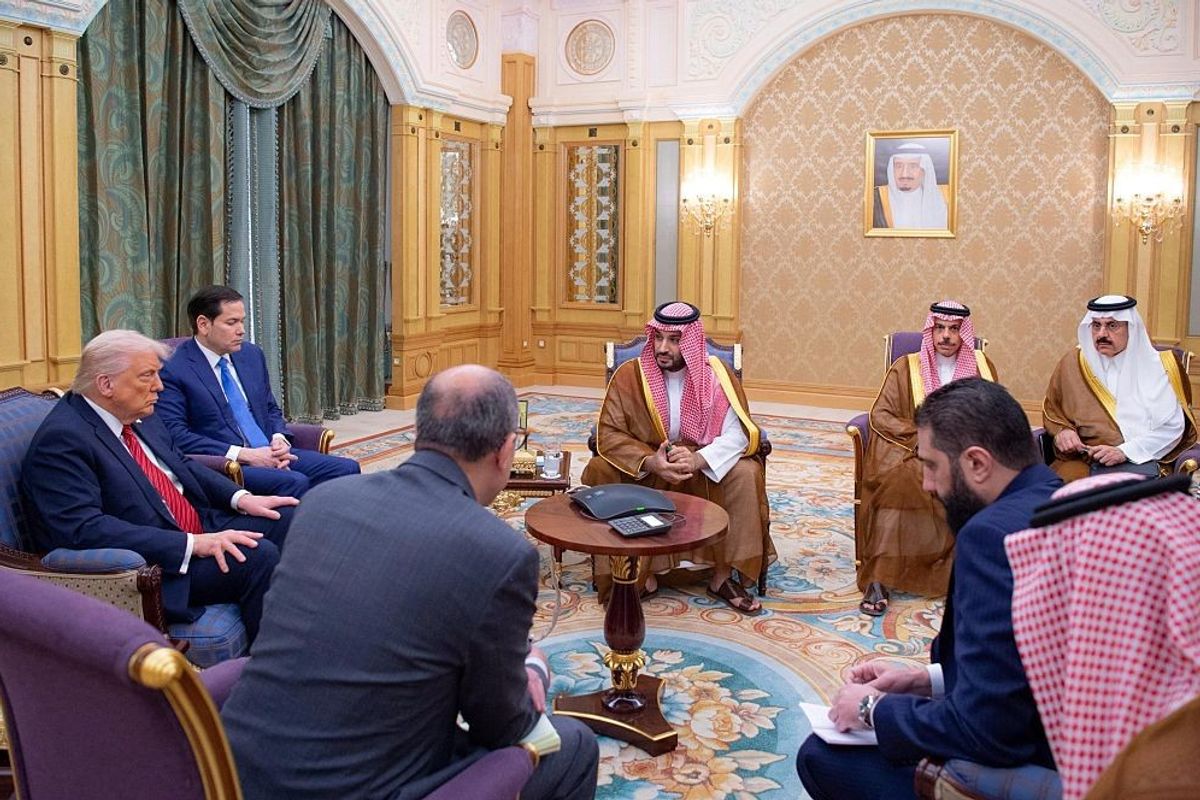Over the weekend, ISIS claimed responsibility for two deadly attacks: in Paris, France, a Chechnyan-born man stabbed five people and released a video pledging allegiance to the group; in Indonesia, suicide bombers detonated explosives at three churches in Surabaya, the second largest city in the country.
Though the terror group continues to lose territory in Syria and Iraq, it increasingly poses a threat in other areas of the world, and through its ideology, which has inspired attacks across the globe. Today's brief is a snapshot of the 2018 Cipher Brief Threat Report. Learn more about the report here.
Bottom Line: The Islamic State, also known as the Islamic State of Iraq and al-Sham (ISIS), has experienced significant territorial losses in its former self-declared caliphate that once spanned large swaths of eastern Syria and western Iraq. However, the group remains a potent international threat as it increasingly adopts conventional insurgent tactics, increases its focus on executing terrorist attacks in the West and doubles down on supporting affiliate organizations across the globe as well as lone wolf actors pursuing inspired attacks in their home countries.
Background: ISIS is the third reincarnation of al-Qaida in Iraq, a group that was originally formed in the aftermath of the Iraq War in 2004 and later changed its name to the Islamic State of Iraq (ISI) in 2006.
- ISIS was expelled from the al-Qaida network in February 2014 after the group’s leader Abu Bakr al-Baghdadi announced the merger of ISIS and al-Qaida’s Syrian affiliate, the Al-Nusra Front, under his leadership – a move that was rejected by both al-Qaida emir Ayman al-Zawahiri and Al-Nusra Front leader Abu-Muhammad al Joulani.[i] Al-Baghdadi and al-Zawahiri also failed to see eye-to-eye on several other issues, such as ISIS’s brutality particularly towards other Muslims.[ii]
- In Iraq, ISIS expediently gained traction in late 2013 through mid-2014, as Sunnis there felt increasingly disenfranchised by a Shia-dominated government based in Baghdad that had instituted what they saw as sectarian policies. Facing little resistance from a battered Iraqi army, ISIS swiftly conquered significant territory in eastern Syria and western Iraq, including Iraq’s second largest city of Mosul. In June 2014, al-Baghdadi announced the establishment of an Islamic caliphate from Mosul’s Grand Mosque. At its peak, ISIS governed approximately 7.7 million people and controlled roughly 40,000 square miles of land, essentially forming a proto-state as large as the United Kingdom.[iii]
- ISIS’s ideology can be divided into three main components:[iv] First is the group’s Salafi interpretation of Islam, which originates from the Arabic word salaf, meaning ancestor, and refers to a version of Islam practiced by the Prophet Muhammad and the earliest generations of Muslims in the seventh century. ISIS subscribes to a brand of Salafism that licenses violence against all those who do not share their religious credence, including fellow Muslims. Second, ISIS insists that Sharia law play an essential role in the group’s political system, with al-Baghdadi assuming the role of political leader and religious authority. Third, ISIS strongly advocates for an apocalyptic vision of a global jihad in which the Muslim world battles the West to achieve global dominion; only by participating in jihad against the West will Muslim lands be saved, an Islamic caliphate created and the world reach its phase of final salvation.
- During its peak earning period from mid-2014 through the end of 2015, ISIS was grossing between $1-3 million per day in November 2014[v] and as much as $80 million per month by the end of 2015.[vi] It generated the bulk of its revenue via illegal oil sales, which brought in nearly $40 million per month, while also relying on antiquities sales, the extortion and taxation of local populations and kidnappings for ransom.[vii]
- Since the U.S. initiated military operations against ISIS targets in August 2014, ISIS’s core in Syria and Iraq has lost approximately 98 percent of the territory it once controlled, including its former Syrian capital of Raqqa and Mosul.[viii] An estimated 3,000 fighters remain in the area, down significantly from the more than 60,000 militants that fought for the group in Syria and Iraq,[ix] including approximately 40,000 foreign fighters originating from over 110 countries.[x] Territorial losses, coupled with precision strikes on ISIS financial hubs, have also depleted the group’s revenue streams, although ISIS’s exploitation of oil still brings in roughly $4 million per month and it has turned to other sources of income, namely black-market antiquities trading, to offset the losses incurred by its oil industry.[xi]
Robert Richer, former Associate Deputy Director for Operations, CIA
“We failed on the strategic aspect of the aftermath of the Iraq invasion. We had no substantive plan for the day after former Iraqi leader Saddam Hussein fell. We allowed Iraqi opposition figures with no real linkages to, or support from the Iraqi people to influence our post-war decisions, with one of the most telling being the dissolution of the Iraqi military, police and security services. This poorly thought-out decision led to the subsequent development of the Sunni uprising, the following insurgency and ultimately to the birth of ISIS.”
Bruce Hoffman, Visiting Senior Fellow, Council on Foreign Relations
“ISIS has been able to accomplish what few other terrorist organization’s historically have ever been capable of achieving: seizing considerable territory; holding it for a protracted period of time and ruling a large indigenous population. Sixteen years ago, Osama bin Laden pledged to dissolve what he railed against as the artificially drawn borders imposed by the West on the Levant and other Muslim lands in the Middle East following World War I. ISIS is seen by its loyalists and supporters as having delivered what bin Laden only promised: providing the clearest repudiation of the 100-year-old Sykes-Picot arrangement.”
Issue: With ISIS decimated in Syria and Iraq, the network has shifted its resources to expanding the influence and lethality of its affiliates in North Africa, the Sahel, the Sinai, Afghanistan and southeast Asia. Furthermore, ISIS continues to inspire terrorist attacks worldwide and maintains a sizeable network of foreign fighters who have returned to their homelands and may seek to carry out local attacks in ISIS’s name.
- ISIS first appeared in Libya in mid-2014 in the eastern town of Derna. By June 2015, ISIS had built a stronghold in the coastal city of Sirte, the hometown of former Libyan strongman Moammar Gadhafi, and conquered nearly 125 miles of the Libyan coast, establishing the group’s most important base outside of Syria and Iraq.[xii] In May 2016, brigades from the western Libyan city of Misrata launched a counterattack against ISIS, pushing them out of both Derna and Sirte by December 2016. Yet ISIS has maintained a strong presence in Libya and remains a potent regional threat, having regrouped and established training centers and operational headquarters in the central and southern parts of the country. General David Rodriguez, former commander of U.S. Africa Command (AFRICOM), estimated in April 2016 that ISIS in Libya maintained a force of between 4,000-6,000 fighters.[xiii]
- Militants who pledged allegiance to ISIS roam the Sahel region, as demonstrated by the October 2017 ambush of a joint U.S.-Nigerien patrol along the Mali-Niger border, which resulted in the deaths four U.S. troops and five Nigerien soldiers.[xiv] The news garnered significant attention and led to the publicizing that there were approximately 800 U.S. forces stationed in Niger and that the U.S. military was operating a key drone base in the area.[xv]
- Originally known as Ansar Beit al-Maqdis, ISIS’s Sinai branch has been active in Egypt’s Sinai Peninsula since 2011. The group pledged allegiance to ISIS leader Abu Bakr al-Baghdadi in November 2014, assuming the name Sinai Province. With an estimated force of between 1,000-1,500 militants,[xvi] Sinai Province claimed responsibility for the October 2015 downing of Russian passenger plane Metrojet Flight 9268, which took off from the Egyptian city of Sharm el-Sheikh, killing all 224 people on board.[xvii] Over the last few years, Sinai Province has frequently attacked Egyptian military and security forces deployed in the Sinai. It has also managed to strike in Egypt’s heartland, conducting several attacks in the capital of Cairo, and bombings of Coptic churches as far west as Alexandria and Tanta.[xviii]
- ISIS in Afghanistan, also called ISIS Khorasan Province (ISKP), first emerged in late 2014 and operates primarily in the country’s eastern Nangarhar Province along the porous Afghan-Pakistan border. According to U.S. military estimates, ISKP has dropped from a peak of between 2,000-3,000 fighters in 2016 to around 1,100 fighters, with between 600-800 militants based in Nangarhar province and an additional 300 in the northern Kunar and Jowzjan provinces combined.[xix] ISIS has carved out a dangerous foothold in Afghanistan as demonstrated by its repeated barrage of attacks against both civilian and military targets in Afghanistan and across the border in Pakistan.
- In May 2017, pro-ISIS militants managed to overrun the city of Marawi located in the southern Philippine Island of Mindanao after Philippine forces raided the house of Isnilon Hapilon, the head of the Abu Sayyaf terrorist organization that had pledged allegiance to ISIS in July 2014. They encountered fiercer-than-expected resistance when Hapilon’s supporters aligned with another pro-ISIS brigade called the Maute Group. After five months and 1,100 total deaths, Philippine forces finally defeated the pro-ISIS militants, killing Hapilon and Omar Maute, the leader of the Maute group.[xx] However, ISIS aims to regroup in Mindanao where it has amplified its force size in recent months as militants have arrived from Syria and Iraq.[xxi] In addition, the country’s island geography has complicated Manila’s centralized authority, particularly over Mindanao, affording jihadist groups the opportunity to establish save havens in areas with limited government oversight.
- Boko Haram pledged allegiance to ISIS in March 2015 becoming the most infamous terrorist group to join the ISIS network. However, after ISIS’s central leadership attempted to replace long-time Boko Haram leader Abubakar Shekau with Abu Musab al-Barnawi in August 2016, an organizational split ensued. Currently, Boko Haram is divided amongst two factions, one loyal to Shekau and the other to Barnawi and ISIS.[xxii] Both continue to strike government officials, troops and civilians from the northeast of the country, despite intervention by a Multinational Joint Task Force (MNJTF) comprised of 8,700 troops from Cameroon, Chad, Niger, and Nigeria to oust Boko Haram militants from the Lake Chad Basin Area.[xxiii] As recently as 2015, the Global Terrorism Index labeled Boko Haram the world’s deadliest terrorist organization.[xxiv]
- ISIS became perhaps the most media savvy terrorist group in history, skillfully exploiting social media websites, such as Twitter and Facebook, and encrypted communication applications, such as Telegram, to recruit new members and lure them to either travel abroad and fight on their behalf, or conduct acts of terror in their home countries. ISIS has managed to convert its grand message into targeted appeals that resonate on an individual basis, attracting a variety of people to its cause. Consequently, ISIS-inspired attacks carried out by “lone wolves” or small bands of homegrown violent extremists continue to represent the primary terrorist threat for the U.S. and its allies.
- ISIS has also attempted to develop a cyber-hacking toolset that could one day rival those of criminal or state-sponsored hacking. To date, ISIS cyberattacks have included website defacement, doxing of personally identifiable information, and distributed denial of service (DDoS) attacks.
Alex Bolling, former CIA Chief of Station
“You are going to see ISIS gravitate to areas that lack central governance. Afghanistan has been historically difficult to rule due to its geography and ethnic makeup. Other places, from the Horn of Africa all the way to the Sahel and North Africa, the Sinai, and even parts of the Arabian Peninsula, also share some of these attributes. ISIS is going to try and take advantage of political instability to establish a caliphate once again.”
Farah Pandith, former Special Representative to Muslim Communities, U.S. Department of State
“Terrorist groups push out their narratives in surround sound. They’re using every single vehicle to weaponize their ideas, whether it is radio, pamphlets, DVDs, Twitter or YouTube. People think that some of these things are from the dark ages and no longer exist, when in fact they don’t die and still do exist. Even though ISIS’s and al-Qaida’s strengths are less on the battlefield, their materials both physical and virtual, don’t get killed. Their ideas are powerful weapons.”
Response: The U.S. government has spearheaded a coalition of countries that have united to combat ISIS in Syria and Iraq and has also launched initiatives to counter ISIS’s propaganda and clamp down on the group’s use of social media to lure in new recruits. In addition, the U.S. has assisted in the training of special forces units in several countries to enhance their counterterrorism operations and supports allies as they battle ISIS militants within their borders.
- In September 2014, the State Department formed a 75-member coalition to combat ISIS, in what became known as the Global Coalition to Defeat ISIS.[xxv] The coalition outlined five lines of effort in which countries could participate to aid in the fight against ISIS: providing military support; impeding the flow of foreign fighters into Syrian and Iraq; reducing ISIS’s financing; addressing humanitarian crises in the region; and countering ISIS’s message.[xxvi]
- Militarily, the U.S. began conducting airstrikes against ISIS targets in Syria and Iraq in August 2014, and in October 2014, the Defense Department established Combined Joint Task Force - Operation Inherent Resolve (CJTF-OIR) to formalize ongoing military actions against ISIS. Between August 2014 and January 2018, the military coalition, comprised of more than 60 nations, conducted a total of 29,070 air strikes on ISIS targets.[xxvii]
- The U.S. has also deployed a limited number of troops to assist local forces in ousting ISIS from Syria and Iraq. Currently, the U.S. maintains nearly 8,000 troops in Iraq[xxviii] and approximately 2,000 in Syria.[xxix] In January 2018, then-U.S. Secretary of State Rex Tillerson stated that the U.S. will maintain a conditions-based military presence in Syria focused on ensuring that ISIS cannot reemerge.”[xxx]
- The U.S. has provided key counterterrorism assistance to allies combatting ISIS cells including in Niger where the U.S. is training local special operations forces in counterterrorism tactics.[xxxi] In the Philippines, the U.S. supplied the Philippine military with critical support throughout the battle for Marawi, including weapons and ammunition, advanced radar systems, and enhanced surveillance equipment such as the Gray Eagle unmanned aerial system.[xxxii]S. forces engaged in joint training exercises focused on improving Manila’s counterterrorism and naval operations.[xxxiii] The U.S. has also offered support for the Egyptian military’s battle against ISIS in the Sinai.[xxxiv]
- The Bureau of Counterterrorism and Countering Violent Extremism, housed at the State Department, has implemented several programs to counter ISIS’s propaganda and has also spearheaded initiatives where the U.S. works alongside foreign partners to strengthen their law enforcement and judicial capabilities and enhance their counter-messaging strategies.[xxxv] Further, the U.S. government has enlisted the assistance of social media companies, such as Facebook, Twitter and YouTube, to identify potential terrorist accounts and remove violent content from their websites. To date, Twitter has disabled nearly 1 million handles publishing pro-ISIS content.[xxxvi]
- Law enforcement agencies have remained vigilant in thwarting terrorist plots against the U.S. homeland as demonstrated by the fact that there has not been a major terrorist attack on American soil since 9/11. However, despite law enforcement’s best efforts, preventing lone assailants from carrying out terrorist acts remains a relentless challenge. The December 2015 San Bernardino shooting,[xxxvii] the June 2016 Orlando nightclub attack[xxxviii] and the October 2018 deadly car ramming in New York[xxxix] are all stark reminders of the difficulty in containing the domestic terrorist threat.
Mitch Silber, former Director of Intelligence Analysis, NYPD
“It’s almost impossible to monitor everyone who you probably want to or would like to. Inevitably, some people are going to get through. You hope that you are able to minimize and reduce those possibilities and turn the odds somewhat slightly in your favor.”
Carol Rollie Flynn, former Associate Deputy Director, National Counterterrorism Center
“This is the price of a free society. It’s also an allocation of resources issue. Do we want to deplete everything else we’re doing with our government funding and throw it all at this problem, when in fact more people are killed in automobile accidents or die from opioid overdoses than are killed in terrorist attacks? Do we really want to take away all of our public health resources to put them into policing? We live in a world where we have to make tradeoffs, and I think that, particularly with individuals operating alone, these people are just very hard to find. The traditional tools of law enforcement are unlikely to find you if you’re not talking to people or if you’re not linked to suspicious groups and individuals.”
Looking Ahead: Despite territorial victories over ISIS in Iraq and Syria, it appears likely that the group will resort to more traditional terrorist tactics and attempt to exert control in weakly governed spaces across Africa, the Middle East and Southeast Asia. Europe, too, could be the next battlefront, as the organization activates pre-positioned cells to carry out attacks and prove it’s still a threat to the West. Key to confronting the ISIS threat is combatting the group’s ideology and propaganda, often disseminated through its online network, as well as addressing the conditions that help spread it, such as poverty, corruption and instability.
Bruce Hoffman, Visiting Senior Fellow, Council on Foreign Relations
“The threat is specifically designed to overwhelm us, and it in fact has proven to be overwhelming. Our law enforcement, intelligence and security services are being swamped by the vast proliferation of terrorist threats and people to be investigated, and if need be, monitored and surveilled. This has greatly strained and tested their capacity to keep pace with an evolving threat posed now by two terrorists movements, unlike one central group in the past.”
Bennett Seftel is the analyst who authored this report. Follow him on Twitter @BennettSeftel. To learn more about the 2018 Cipher Brief Threat Report, click here.
[i] Sly, Liz. “Al-Qaeda disavows any ties with radical Islamist ISIS group in Syria, Iraq.” The Washington Post, 3 Feb. 2014, https://www.washingtonpost.com/world/middle_east/al-qaeda-disavows-any-ties-with-radical-islamist-isis-group-in-syria-iraq/2014/02/03/2c9afc3a-8cef-11e3-98ab-fe5228217bd1_story.html?utm_term=.8b08c50870edfe5228217bd1_story.html?utm_term=.3dce59580e87.
[ii] Byman, Daniel L. and Jennifer R. Williams. “ISIS vs. Al Qaeda: Jihadism’s global civil war.” Brookings Institution, 24 Feb. 2015, https://www.brookings.edu/articles/isis-vs-al-qaeda-jihadisms-global-civil-war/.
[iii] McGurk, Brett. “Update on the D-ISIS Campaign.” U.S. Department of State, 21 Dec. 2017, https://www.state.gov/r/pa/prs/ps/2017/12/276746.htm.
[iv] Seftel, Bennett. “What Drives ISIS.” The Cipher Brief, 5 May 2016, https://www.thecipherbrief.com/what-drives-isis.
[v] Johnston, Patrick B. “Countering ISIL’s Financing.” Rand Corporation, Nov. 13 2014, https://www.rand.org/content/dam/rand/pubs/testimonies/CT400/CT419/RAND_CT419.pdf.
[vi] Begley, Sarah. “Report: ISIS Makes $80 Million a Month in Revenue.” Time, Dec. 7 2015, https://time.com/4139562/isis-80-million-monthly-revenue/.
[vii] Faulconbridge, Guy and Jonathan Saul. “Islamic State oil is going to Assad, some to Turkey, U.S. official says.” Reuters, Dec. 10 2015, https://www.reuters.com/article/us-mideast-crisis-syria-usa-oil/islamic-state-oil-is-going-to-assad-some-to-turkey-u-s-official-says-idUSKBN0TT2O120151210.
[viii] McGurk, Brett. “Update on the D-ISIS Campaign.” U.S. Department of State, 21 Dec. 2017, https://www.state.gov/r/pa/prs/ps/2017/12/276746.htm.
[ix] Seck, Hope Hodge. “SpecOps Commander: 60,000 ISIS Fighters Killed by US Troops.” Military.com, 2018, https://www.military.com/daily-news/2017/02/14/specops-commander-60000-isis-fighters-killed-by-us-troops.html.
[x] McGurk, Brett. “Press Conference by Special Presidential Envoy McGurk in Baghdad, Iraq.” U.S. Department of State, Mar. 12 2017, https://www.state.gov/s/seci/2017remarks/268378.htm.
[xi] Michaels, Jim. “U.S. coalition slashes ISIS oil revenue by more than 90%.” USA Today, Oct. 2 2017, https://www.usatoday.com/story/news/world/2017/10/02/u-s-coalition-slashes-isis-oil-revenue-more-than-90/717303001/.
[xii] Al-Warfalli, Ayman and Ahmed Elumami. “Islamic State attack sets storage tanks ablaze at Libyan oil terminal.” Reuters, Jan. 21 2016, https://www.reuters.com/article/us-libya-security/islamic-state-attack-sets-storage-tanks-ablaze-at-libyan-oil-terminal-idUSKCN0UZ0P0.
[xiii] Rodriguez, David M. “Department of Defense Briefing by Gen. David M. Rodriguez.” U.S. Department of Defense, Apr. 7 2016, https://www.defense.gov/News/Transcripts/Transcript-View/Article/715846/department-of-defense-briefing-by-gen-david-m-rodriguez/.
[xiv] “4th U.S. soldier dead after attack in Niger, U.S. officials say.” USA Today, Oct. 6 2017, https://www.usatoday.com/story/news/world/2017/10/06/niger-4th-us-soldier-dead-ambush-attack/740929001/.
[xv] Lewis, David and Joe Bavier. “U.S. deaths in Niger highlight Africa military mission creep.” Reuters, Oct. 6 2017, https://www.reuters.com/article/us-usa-africa-security/u-s-deaths-in-niger-highlight-africa-military-mission-creep-idUSKBN1CB2J1.
[xvi] “Sinai Province: Egypt's most dangerous group.” BBC News, May 12, 2016, https://www.bbc.com/news/world-middle-east-25882504.
[xvii] Hanna, Jason, Michael Matinez, and Jennifer Deaton. “ISIS publishes photo of what it says is bomb that downed Russian plane.” CNN, Nov. 19 2015, https://www.cnn.com/2015/11/18/middleeast/metrojet-crash-dabiq-claim/index.html.
[xviii] Sterling, Joe, Faith Karimi, Mohammed Tawfeeq, and Hamdi Alkhshali, “ISIS claims responsibility for Palm Sunday church bombings in Egypt.” CNN, Apr. 10 2017, https://www.cnn.com/2017/04/09/middleeast/egypt-church-explosion/index.html.
[xix] Gul, Ayaz. “US Military: Number of IS Members in Afghanistan Reduced to 700.” Voice of America, Mar. 1 2017, https://www.voanews.com/a/afghanistan-islamic-state/3745401.html.
[xx] Gomez, Jim. “Philippines declares militants in Marawi 'finished.’” Chicago Tribune, Oct. 23 2017, https://www.chicagotribune.com/news/nationworld/ct-philippines-troops-find-dead-marawi-20171022-story.html.
[xxi] Mogato, Manuel. “Defeats in Middle East driving Islamic State fighters to Philippines – separatist.” Reuters, 20 Feb. 2018, https://www.reuters.com/article/us-philippines-militants/defeats-in-middle-east-driving-islamic-state-fighters-to-philippines-separatist-idUSKCN1G40UF.
[xxii] “Boko Haram Split Creates Two Deadly Forces.” Voice of America, Aug. 2 2017, https://www.voanews.com/a/boko-haram-split-two-deadly-forces/3970425.html.
[xxiii] “Funding falls short for task force to fight Nigeria's Boko Haram.” Reuters, Feb. 2 2016, https://www.reuters.com/article/us-nigeria-violence-funding/funding-falls-short-for-task-force-to-fight-nigerias-boko-haram-idUSKCN0VB215.
[xxiv] “Global Terrorism Index 2015.” Institute for Economics & Peace, 2015, https://economicsandpeace.org/wp-content/uploads/2015/11/Global-Terrorism-Index-2015.pdf.
[xxv] “Guiding Principles from the Global Coalition to defeat Daesh.” The Global Coalition Against Daesh, 2018, https://theglobalcoalition.org/en/home/.
[xxvi] “The Global Coalition To Defeat ISIS.” U.S. Department of State, Sep. 10 2014, https://www.state.gov/s/seci/.
[xxvii] “CJTF-OIR Monthly Civilian Casualty Report.” Operation Inherent Resolve, Feb. 22 2018, https://www.inherentresolve.mil/News/News-Releases/News-Article-View/Article/1447350/cjtf-oir-monthly-civilian-casualty-report/.
[xxviii] “DoD Personnel, Workforce Reports & Publications.” Defense Manpower Data Center, 2018, https://www.dmdc.osd.mil/appj/dwp/dwp_reports.jsp.
[xxix] Ismay, John. “U.S. Says 2,000 Troops Are in Syria, a Fourfold Increase.” The New York Times, Dec. 6 2017, https://www.nytimes.com/2017/12/06/world/middleeast/us-troops-syria.html?mtrref=www.google.com.
[xxx] Tillerson, Rex W. “Remarks on the Way Forward for the United States Regarding Syria.” U.S. Department of State, Jan. 17, 2018, https://www.state.gov/secretary/remarks/2018/01/277493.htm.
[xxxi] Myers, Meghann. “Army troops, Special Forces train Nigerian infantry for fight against Boko Haram, ISIS.” ArmyTimes, Feb. 23 2018, https://www.armytimes.com/news/your-army/2018/02/23/special-forces-troops-train-nigerian-infantry-for-fight-against-boko-haram-isis/.
[xxxii] Wakefield, Francis and Freddie Lazaro. “US deploys unmanned surveillance aircraft to Mindanao.” Manila Bulletin, Sep. 12 2017, https://news.mb.com.ph/2017/09/12/us-deploys-unmanned-surveillance-aircraft-to-mindanao/.
[xxxiii] “Commandos storm plane in Philippines-U.S. hijack simulation.” Reuters, Sep. 26 2017, https://www.reuters.com/article/us-philippines-usa-security/commandos-storm-plane-in-philippines-u-s-hijack-simulation-idUSKCN1C116P.
[xxxiv] “President El Sisi Speaks with President Donald Trump.” Embassy of the Arab Republic of Egypt, Nov. 28 2017, https://www.egyptembassy.net/news/news/president-el-sisi-speaks-with-president-donald-trump/.
[xxxv] “Bureau of Counterterrorism and Countering Violent Extremism.” U.S. Department of State, https://www.state.gov/j/ct/.
[xxxvi] O’Brien, Sara Ashley. “Twitter has shut down nearly 1 million terrorist accounts in two years.” CNN, Sep. 19 2017, https://money.cnn.com/2017/09/19/technology/business/twitter-transparency-report/index.html.
[xxxvii] “San Bernardino shooting.” CNN, https://www.cnn.com/specials/san-bernardino-shooting.
[xxxviii] Stapleton, AnneClaire and Ralph Ellis. “Timeline of Orlando nightclub shooting.” CNN, Jun. 17 2016, https://www.cnn.com/2016/06/12/us/orlando-shooting-timeline/index.html.
[xxxix] “What can be done to prevent deadly car rammings?” Daily News, Dec. 22 2017, https://www.nydailynews.com/newswires/new-york/prevent-deadly-car-rammings-article-1.3715629.



















